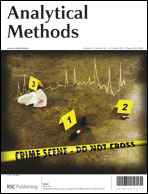The increasingly large quantities of potentially illicit samples received for confirmatory analysis highlights the importance and demand for preliminary testing procedures that are simple, rapid, selective, inexpensive and able to be used in the field. Colour testing fulfils the aforementioned requirements and is a technique frequently employed to achieve presumptive identification. Piperazine analogues (often marketed as ‘legal ecstasy’) are a group of psychoactive substances that have recently become established on the illicit drug market and are not effectively discriminated or identified by current colour testing methods. Herein, we report on the development and validation of a chemical spot test for piperazine analogues present in unknown seized materials using the spectrophotometric reagent, sodium 1,2-naphthoquinone-4-sulphonate (NQS). Primary testing revealed that NQS reacts almost instantly to form an intense, bright orange-red coloured complex with the representative piperazine 1-benzylpiperazine (BZP) at room temperature. The results of the test, assessed by colour development, were evaluated visually and variables affecting the coloured reaction were optimised. The colour test method was validated to meet requirements for use in preliminary screening, providing qualitative and reliable presumptive test results. Validation studies show that the characteristic colour change is unique to the piperazine class at room temperature, and is unaffected by the presence of common cutting agents, i.e. glucose and caffeine, in test samples of 5% purity, and other drugs such as N-methyl-3,4-methylenedioxyamphetamine (MDMA). The NQS reagent stability was found to be limited to storage in a refrigerated environment for no more than one week before results were affected. The operational limit of detection was found to be 40 μg.

This article is Open Access
 Please wait while we load your content...
Something went wrong. Try again?
Please wait while we load your content...
Something went wrong. Try again?


 Please wait while we load your content...
Please wait while we load your content...